Our Story of Wild Camping and Road Tripping in the Outer Hebrides
Wrangling with tent poles in the savage coastal winds of the Outer Hebrides wasn’t how I pictured my first wild camping trip. My friend Helen and I thought we were so clever camping on a raised grassy verge on the beach (think of the pictures!) but as soon as we started setting up, the storm began.
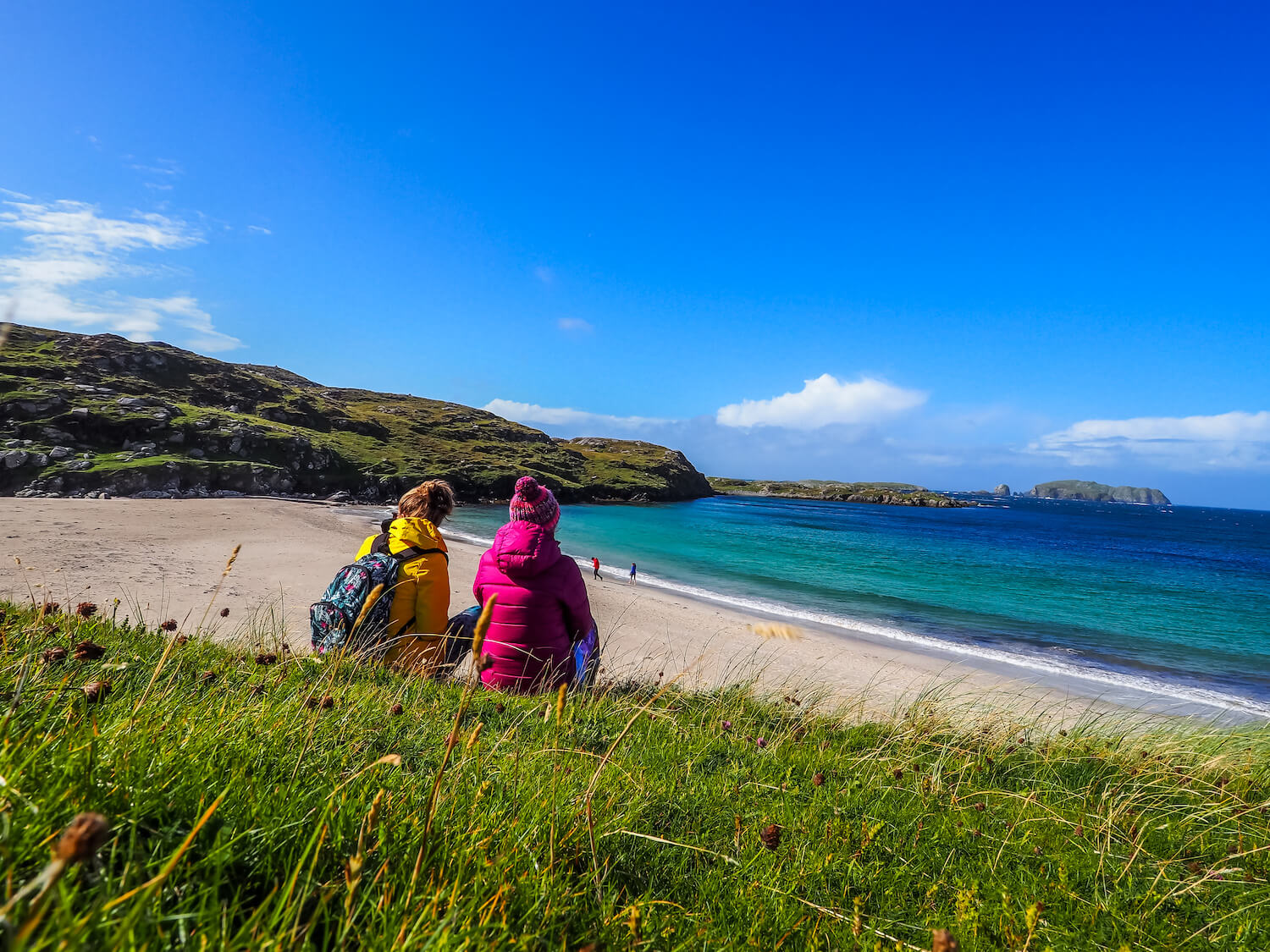
It was all good fun though, laughing with Helen as we grappled with the guy ropes attempting to peg them down. Cackling at our failure to prepare or stay one step ahead of the weather situation. At that point we had no idea of the sleepless night ahead of us and hastily finished putting up the tent. We were both eager to head back into Barra island’s main village of Castlebay for an Indian meal at Kisimul Restaurant, by the castle, to warm us up.
The last time we would be warm for at least 12 hours it turned out.
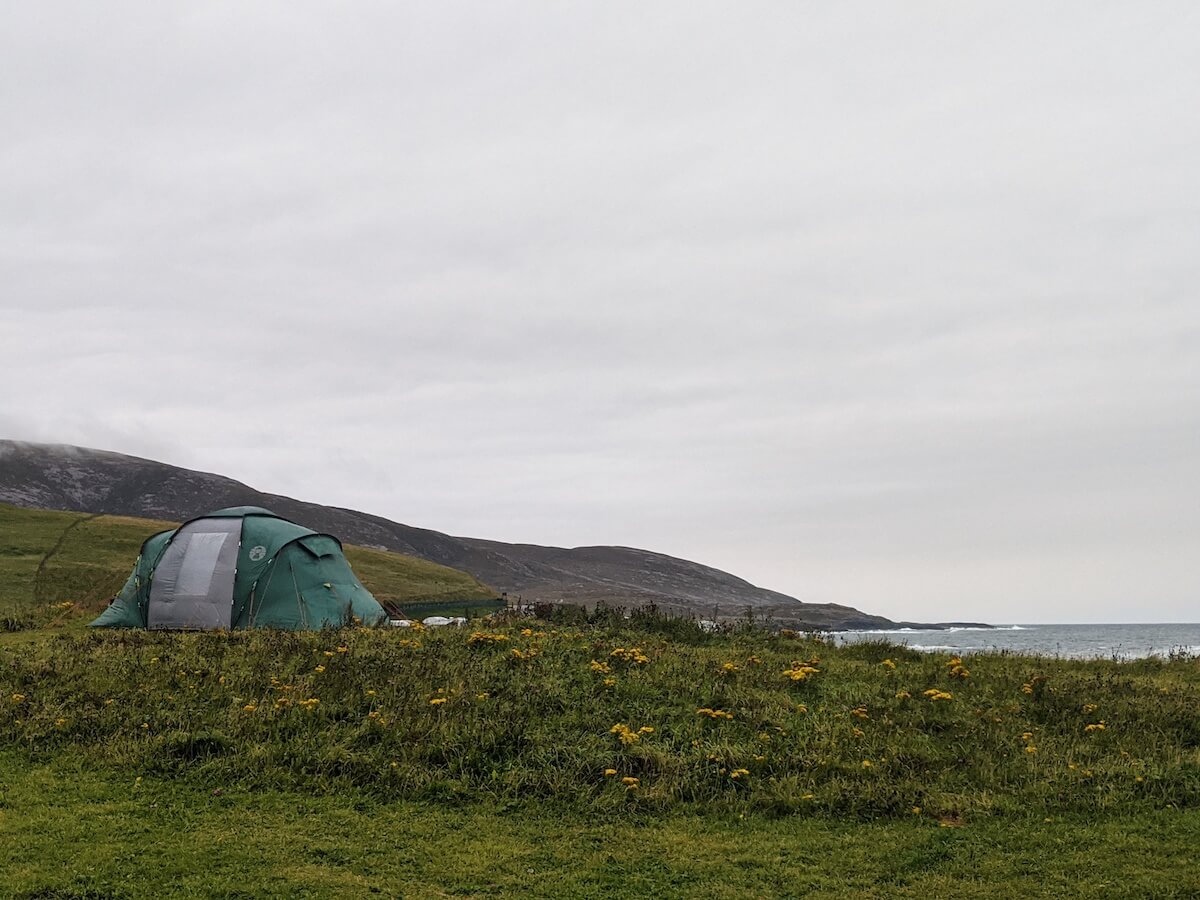
We spent that night inside the two-metre high tent – far too high for wild camping in a Scottish storm – desperately trying to get warm in our separate pods. The fly sheet of the ‘hastily’ erected tent was now flapping where we hadn’t pegged it, neither of us had put the top on so it was leaking, and what tent pegs there were, were slowly being ripped from the soft ground by the coastal gale.
Have you ever laid awake at night debating the probability of being blown away by gale force winds?
I have.
At one point in the middle of the night I got up to try and fix the tent pegs in better than they were, to stop the flapping. I just looked in despair at the tent, we’d done a terrible job.
The two us were unable to sleep, deliriously laughing at the state of our reality in comparison to what we’d imagined.
There was no other choice than to just wait, and try to sleep. Our tent erecting efforts were no match for the winds of the Western Isles of Scotland.
Visiting the Outer Hebrides
We’d come to the Outer Hebrides in between lockdowns in September, in desperate search of adventure. After being stuck at home for months and summer almost coming to an end, my friend and I needed to get out and do something new. The Outer Hebrides seemed like a great answer thanks to the remoteness, the relative closeness, yet the fact we still got to go on a ferry and really feel like we were travelling.
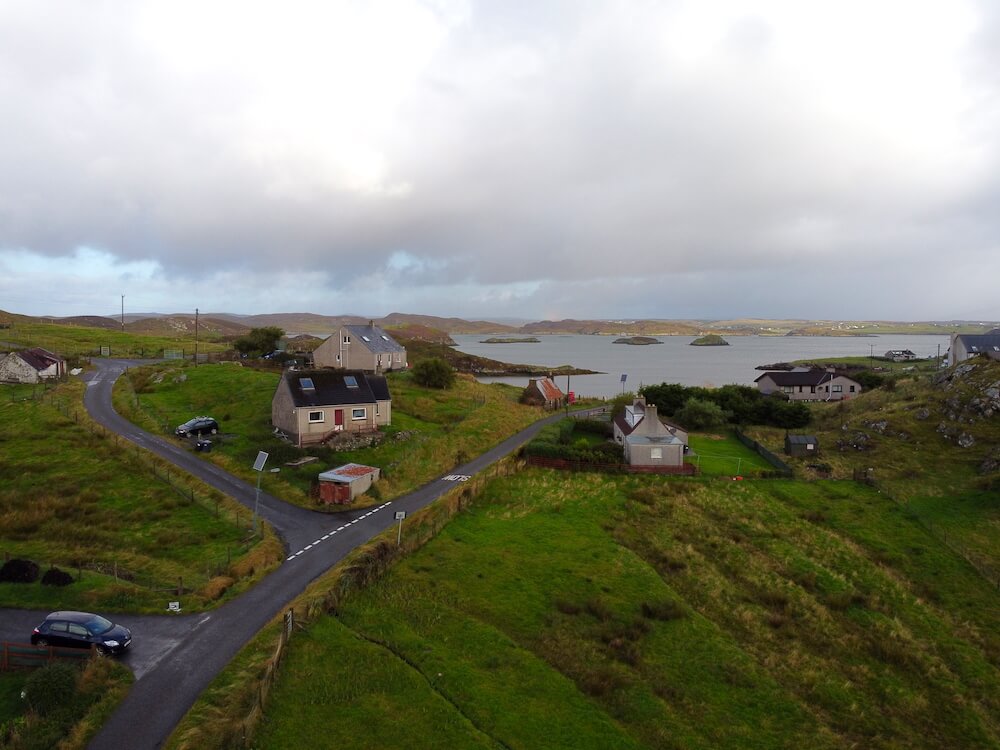
It was all very last minute, with me planning our ferries and itinerary just a few days before.
We travelled over from Oban to Castlebay – a four-hour ferry journey known to be a bit rough. Easy I thought – I can do that!
Cue two of the four hours of me sitting on the lower deck barely able to move for fear of being sick. That crossing is not for the faint hearted, or stomached.
From Barra we road tripped north to Eriskay on the Isle of South Uist, and up the length of the island to North Uist to travel the length of that too. From the north of the island, in Berneray, we crossed over to Leverburgh on the Isle of Harris. Here we drove up to Stornoway – the capital of Lewis and Harris – and back down again to Tarbert for our final night to get the ferry back across to Uig, on Skye, just a bridge away from the mainland. Our Outer Hebrides road trip route was ambitious and would be over 350 miles of driving in less than a week.
An adventure!
We’d planned to wild camp as much as possible, to keep it cheap, but with the storms being so bad even the locals were talking about it, wild camping on the Outer Hebrides proved more difficult than we imagined.
Beaches in the Outer Hebrides
It was the pictures of the beaches in the Outer Hebrides I saw on Instagram that drew me in. White sands, rugged coasts and azure waters… in Scotland!
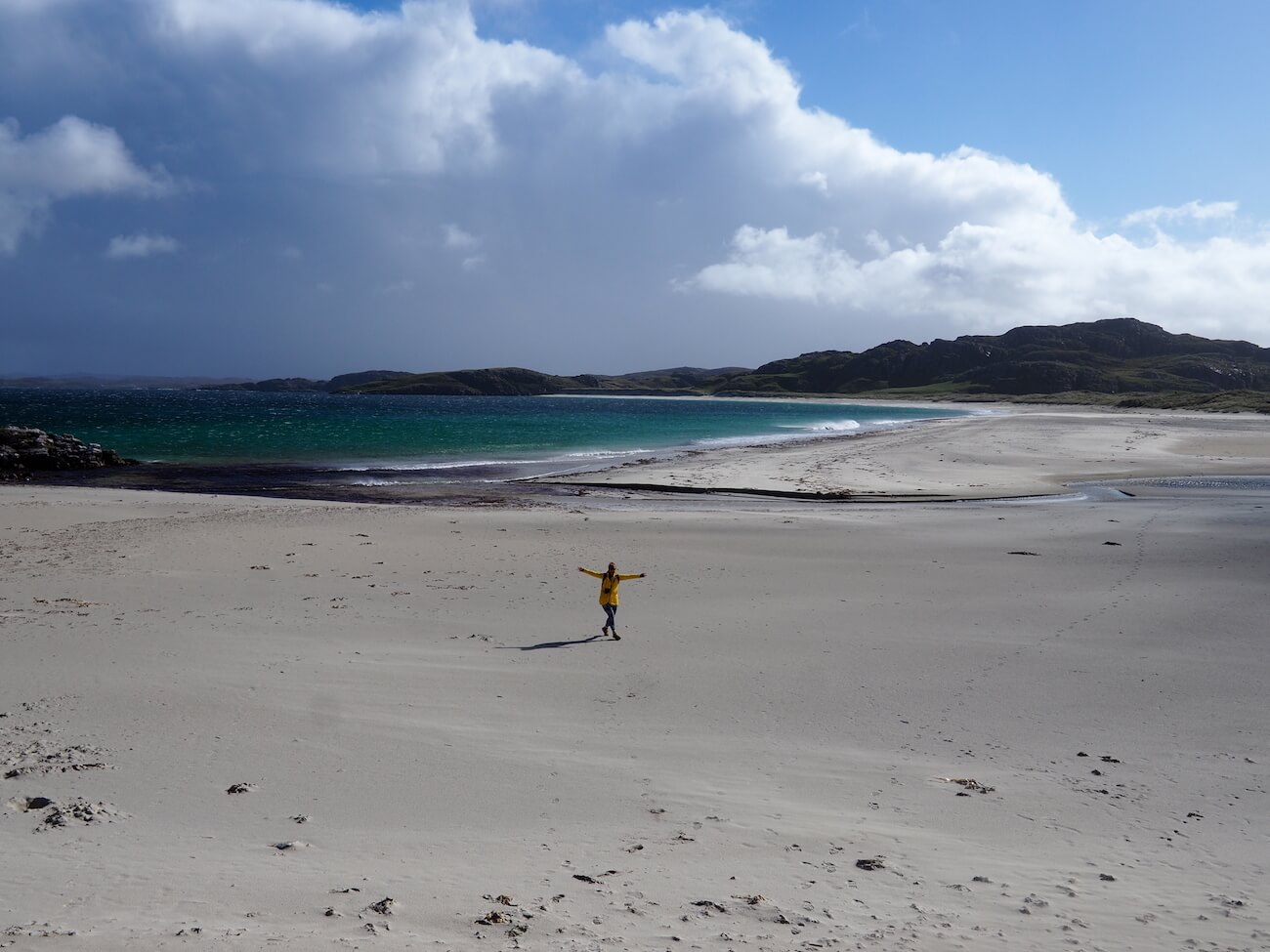
There are over 100 islands in the Outer Hebrides, only 15 of them are inhabited, with almost half a million people. There’s space up here, and that’s what we’d come for.
Sweet, fresh space.
The other main attraction, beyond the beaches and space, is the fact that wild camping is legal in Scotland, unlike in England. And with campsites and hotels in England full to capacity over the summer, camping in the Outer Hebrides seemed like the perfect socially distanced activity for two adventure-starved travel lovers.
Check out our next adventure, when we went wild camping in the Lake District.
Outer Hebrides road trip
Driving up through the Hebrides was amazing. We crossed from island to island by ferry – the late summer views and colours were just fantastic. With so much coastline, empty roads and the famous Outer Hebridean machair (the grassy plains) vibrant in colour, it was a beautiful time to be there. The few attractions there are on the islands were closed, and so our full attention was given to the natural beauty laid out in front of us.
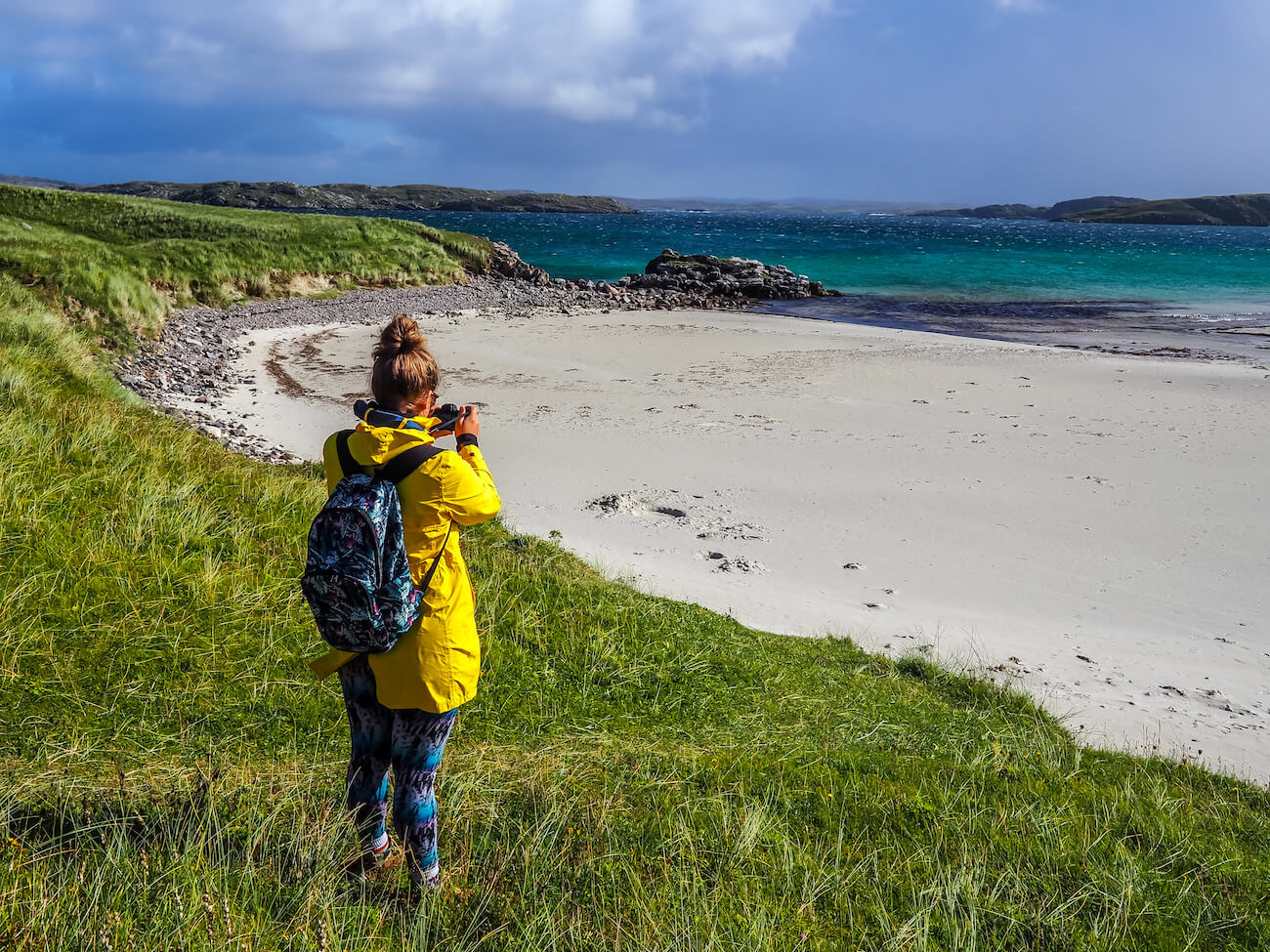
Highlights of our adventure included the beach airport runway at Barra – the only one in the world where scheduled flights use a tidal beach as the runway. It’s fun to go and watch the plane come in, with all the other plane spotters. Also, Traigh a Bhaigh Beach on Varetsay off Barra was a feast for the eyes – admittedly because it coincided with the best weather we had all week.
Our day on Lewis included hiking, exploring the beaches, enjoying the Circular Scenic Route (which included the impressive Reef Beach), going to see the Callanish Stones, learning about the chess pieces of Lewis, and enjoying the Old Village – a replica of how the houses here used to be. Well, the quick look we had around the outside, as that too, wasn’t open.
In Harris we spent our day exploring Seilebost Beach, Luskentyre Beach, walking to the Eilean Glas Lighthouse on the Island of Scalpay, shopping in Tarbert, wishing we could go in the Harris Distillery, and generally having a lovely time with the freedom of our wheels.
Wild camping on Benbecula
After the failure of that first night of wild camping we tried again in Cula Bay on Benbecula, South Uist. Again, on a beach, again, on a grassy verge. Do we learn?
A lady walking her dog took pity on us. Round two of us wrestling with the poles in the coastal wind and for some reason thinking this would have a different outcome. Not so.
She knew we’d fail. She knew before we did.
“If you can’t get that thing up, my house is the one with the blue door down there” – she chirped as she went past.
So kind, but there was no way Helen and I were admitting defeat so soon, and so publicly.
As darkness fell, and all we had around us was wind and the sound of the sea, and the disappointment in ourselves rather than a tent, Helen slept in the car and I bought my one-man tent out for a very uncomfortable night of tossing and turning.
We put it down to a learning opportunity for both of us.
Lesson in wild camping
Despite the cold, and the lack of sleep, and what inevitably ended in broken tent poles – waking up on the beaches was so freeing. The fun of ‘sleeping’ where we chose, rather than where we booked and paid was liberating.
It’s easy to see how and why wild camping is so popular, and addictive.
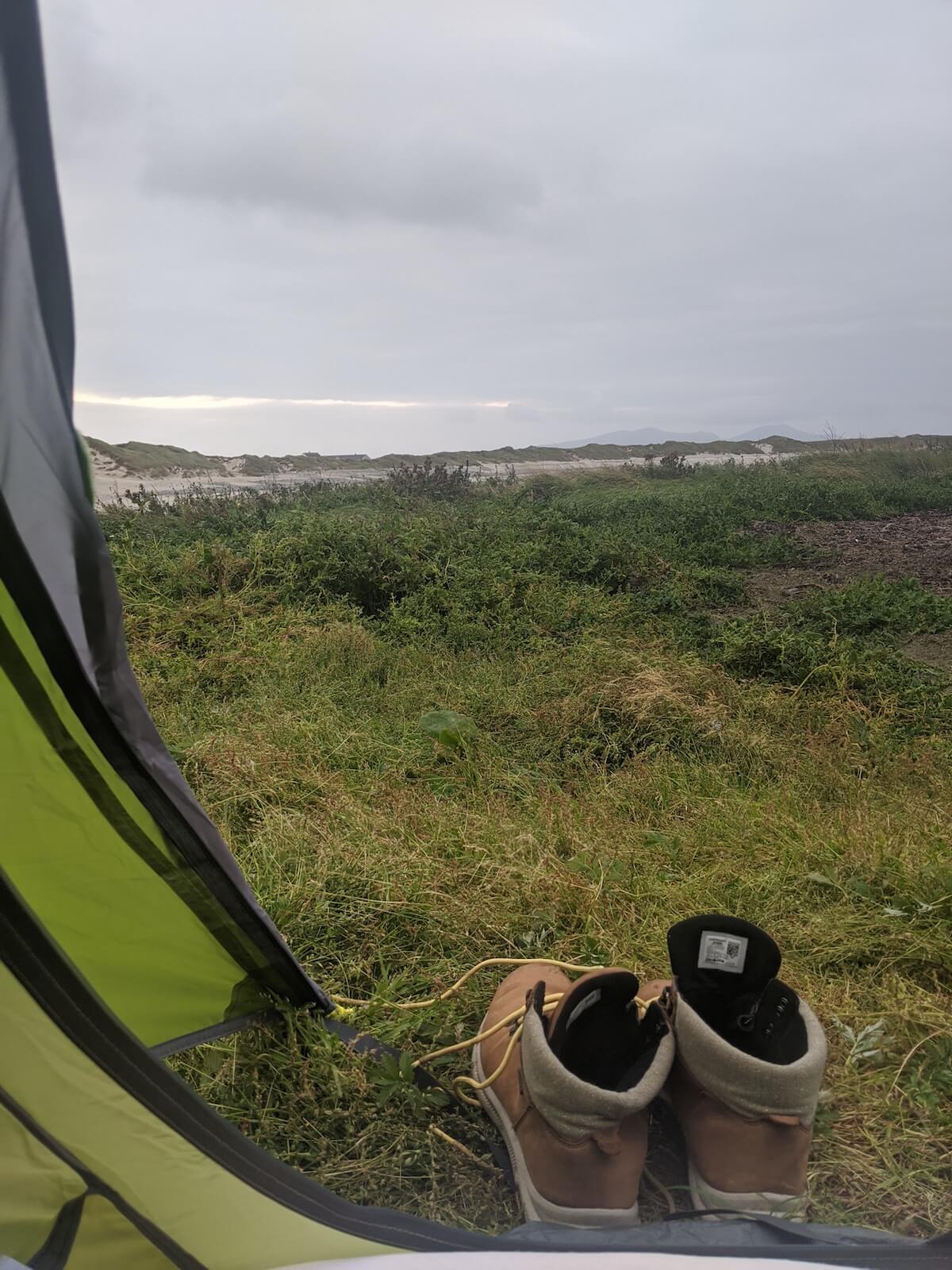
Wild camping is the perfect way to keep your distance from other people, and to enjoy the solace that comes from camping outside wherever you want. We barely saw a soul during our trip in the evenings. Anyone who was ‘wild camping’ was doing it in a campervan or motorhome and they were not coming out.
Over a few red wines sat on the picnic mat that evening, with the sound of the sea lashing in the background, we agreed that this particular trip wasn’t made for wild camping, and we’d come back when we were better equipped.
Tomorrow, we look for a B&B. One day, we’ll try again.
Advice for wild camping and driving in the Outer Hebrides
Wild camping in Scotland is perfectly legal, but there are rules to keep it fun and open to all. If you’re feeling inspired by my wild camping adventure and want to give it a go in the Outer Hebrides, make sure to follow the Scotland wild camping rules to keep it free and open for all.
The main rules are:
- You won’t stay longer than three nights in one place.
- You’ll leave the spot how you find it (or better!).
- No fires.
- Respect animals, nature and other people.
Top tips for wild camping
You need to be prepared for wild camping in the Outer Hebrides. Let me take you through a few lessons learned the hard way, so you don’t make the same mistakes!
– When you choose a spot to camp, look for some sort of shelter. At least from one direction. But, don’t camp between two high points as the wind will funnel through to you. That fresh coastal air can become a howling gale very quickly!
– Getting the tent up is one thing, but getting the pegs to stay in the ground is another. So much of Scotland is either boggy, or dry – so you may have trouble with the tent pegs. I’d recommend getting some storm pegs for extra resilience.
– Don’t camp next to a stream, or any body of water, as little brooks can easily turn into torrents. You do NOT want to wake up to a river in your tent.
– Don’t move rocks or dig ditches to make your camping spot better. That’s not how wild camping in Scotland works. And don’t camp near people’s homes, or within view from their house – they won’t like it.
– My tent was too high, too hard to put up, and there was too much fabric to cope with in the wind. When it comes to choosing a tent, go small, basic and as minimal as possible.
– No matter what the time of years, expect the nights to be cold and pack extra warmth for your tent and sleeping bag.
– Arrive in good time to your spot, so you have the time to pick an exact spot before nightfall.
READ MORE: Best Hotels in the Outer Hebrides
Top tips for driving
– Don’t worry about the islands’ road conditions. The roads were amazingly well kept and other motorists were very courteous – we didn’t have a problem.
– You need to adhere to the rule of passing places and pull over if the passing place is on your side of the road.
– Let other drivers pass, as they might be on their way to work while you’re chugging along admiring the view.
– Keep your petrol topped up as it could be some time between stops.
– Download your maps to your phone before you start as you might not have phone reception for your trip. Any cafe or restaurant we asked was happy to give out their Wi-Fi code with a purchase so we were ok.
– Spend some money locally rather than taking your own food or using supermarkets. Try the fish market for lunch in Oban, pick up some treats from the community shop in Harris, try the Hebridean Toffee and eat out to taste the local cuisine. It’s tempting to be 100% prepared, but it’s fun to sample local produce and really helps the local communities too.
Packing list for your trip
A lightweight tent that’s super easy to pitch, and light.
Take a good quality all season sleeping bag, and an insulated mat too. Maybe some sort of pillow? Up to you whether you can be bothered to carry it or not.
You need a way to get water. I was fine with two bottles kept filled and kept in the car but you can get water treatment tablets from Boots easily enough.
Camping stove, with a gas cartridge.
Take a phone power bank, and the midge repellant.
You might want to bring a First Aid Kit, a repair kit for the tent, and some hand sanitising gel too. Make sure your toiletries are all biodegradable.
Some sort of picnic mat to sit out at night. If you’re in little hiking tents there’s no space to sit up.
